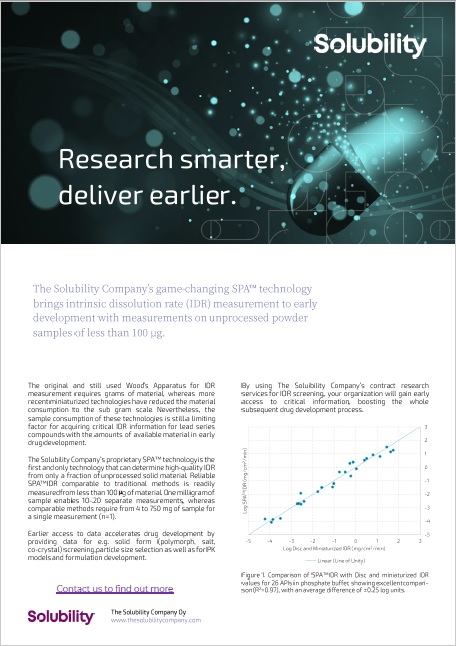Dissolution Rate is critical for the development of new drug modalities. The SPA™ Method measures the rate of dissolution of a pure sample when all important parameters are known (surface area, temperature, agitation/stirring speed, medium pH, and ionic strength). With <100ug of sample you can measure rather than predict downstream issues. The SPA™ Method gives earlier information to help select for example the most optimal polymorph or salt to move forward with in development.

All FREE Whitepapers are available to download today:
SPA™ Technology Whitepaper
Chemistry Agnostic Whitepaper
UPDATED! Comparison SPA™ Assay vs Shake Flask Whitepaper
SPA™ Assisted Modelling Whitepaper.
Quickest, Earliest IDR Data Ever!
Increase the accuracy of your models with accurate experimental data.
IDR data generated alongside SPA™ Solubility Data, as a powerful tool for Polymorph screens.
Using the SPA method
Short Assay Time
The surface area determined for each particle
Less than 100ug of sample
Buffers used
USP or custom buffers ranging from pH 1.0 up to pH 14.0
Process solvents
Biorelevant buffers: FaSSGF, FeSSIF, FaSSIF

Please enter your name and email address below, and we’ll get back to you as soon as possible.
Thank you for your interest in The Solubility Company.
Results are fully reported to the client normally within 10 days of the sample arriving in Helsinki, faster turnarounds are available for time-critical projects.
SPA™ solubility is measured from less than 100 μg of solid sample
The development route of an API and pKa from solubility profile, using the SPA™ Method
NEW!
Polarized Light Microscopy Service, determine if your sample is crystaline or amorphous

Viikinkaari 4
00790 Helsinki
FINLAND
1 Broadway
Cambridge MA 01242
United States